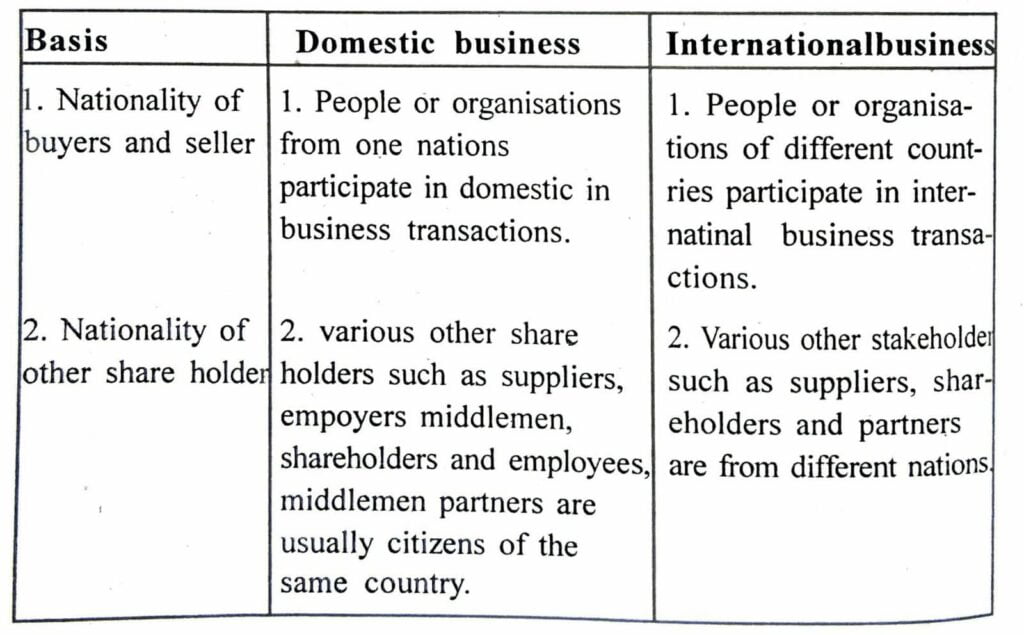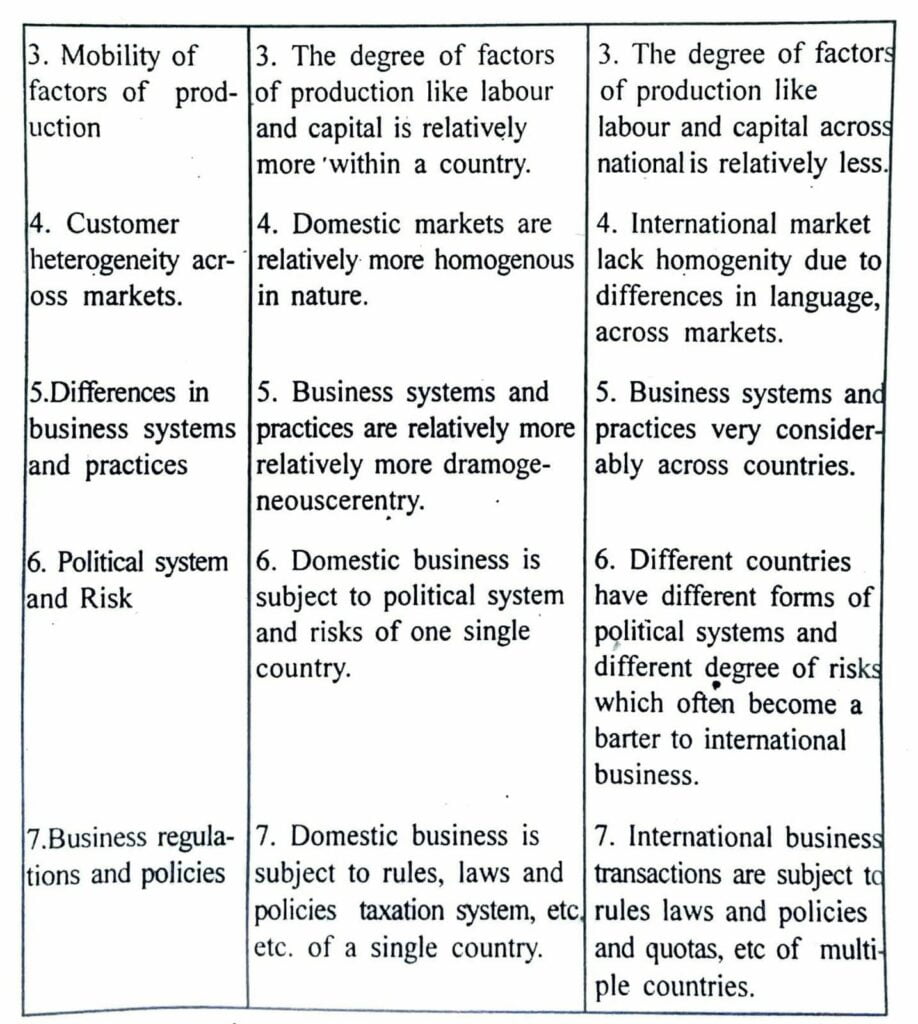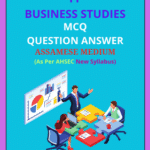Class 11 Business Studies Chapter 11 International Business – I Question answers to each chapter are provided in the list so that you can easily browse through different chapters HS 1st Year Business Studies Notes, AHSEC Class 11 Business Studies Chapter 11 International Business – I, AHSEC Class 11 Business Studies Question Answer In English and select needs one.
Class 11 Business Studies Chapter 11 International Business – I
Also, you can read the NCERT book Notes Class 11 Business Studies Chapter 11 International Business – I online in these sections Solutions by Expert Teachers as per AHSEC Class 11 Business Studies Chapter 11 International Business – I (CBSE) Book guidelines. These solutions are part of AHSEC All Subject Solutions. Here we have given Assam Board Class 11 Business Studies Chapter 11 International Business – I Solutions for All Subjects, You can practice these here NCERT Class 11 Business Studies Chapter 11 International Business – I.
International Business – I
Chapter: 11
VERY SHORT TYPE QUESTIONS ANSWERS (1 MARK EACH)
A. Multiple Choice Question:
1. In which of the following modes of entry, does the domestic manufacturer give the right to use intellectual property such as patent and trademark to a manufacturer in a foreign country for a fee-
(a) Licensing.
(b) Contract manufacturing.
(c) Joint venture.
(d) None of these.
Ans: (a) Licensing.
2. Outsourcing a part of or entire production and concentrating on marketing operations in international business is known as-
(a) Leasing.
(b) Franchising.
(c) Contract manufacturing.
(d) Joint venture.
Ans: (c) Contract manufacturing.
3. When two or more firms come together to create a new business entity that is legally separate and distinct from its parents it is known as-
(a) Contract manufacturing.
(b) Franchising.
(c) Joint ventures.
(d) Licensing.
Ans: (c) Joint ventures.
4. Which of the following is not an advantage of exporting?
(a) Easier way to enter into international markets.
(b) Comparatively lower risks.
(c) Limited presence in foreign markets.
(d) Less investment requirement.
Ans: (c) Limited presence in foreign markets.
5. Which one of the following modes of entry requires higher level of risks?
(a) Licensing.
(b) Franchising.
(c) Contract manufacturing.
(d) Joint venture.
Ans: (d) Joint venture.
6. Which one of the following modes of entry permits greatest degree of over overseas operations?
(a) Licensing/ franchising.
(b) Wholly owned subsidiary.
(c) Contract manufacturing.
(d) Joint venture.
Ans: (c) Contract manufacturing.
7. Which are of the following modes of entry brings the firm closer to international markets?
Ans: (d) Joint venture.
8. Which one of the following is not among India’s major export items?
(a) Textiles and garments.
(b) Gems and Jewellery.
(c) Oil and petroleum products.
(d) Basmati rice.
Ans: (d) Basmati Rice.
9. Which one of the following is not amongst India’s major import items?
(a) Ayurvedic.
(b) Oil and petroleum products.
(c) Pearls and Precious stores.
(d) Machinery.
Ans: (a) Ayurvedic.
10. Which one of the following is not amongst India’s trading partners?
(a) USA.
(b) UK.
(c) Germany.
(d) New Zealand.
Ans: (d) New Zealand
Short & Long Answer Questions
1. Differences between international trade and international business.
Ans: International trade, comprising exports and imports of good, has historically been an important component of international business. But, international business includes all activities such as international travel and tourism, transportation, communication, banking, warehousing. distribution and advertising has considerably grows. All these activities form part of international business.
So, international business is used in wider sense, and international trade is a part of international business.
2. Discuss any three advantages of international business?
Ans: Following are the three advantages of internal business:
(i) Earning of foreign exchanges: By international business a country can earn foreign exchange, which helps in meeting its imports of capital goods, technology petroleum products and fertilisers, pharmaceutical products and a host of other consumer product.
(ii) Efficient use of consumers: By the international business a country can give more attention on product of its suitable goods its surplus can be exported and thereby other goods can be imported.
(iii) Improving growth prospects: By virtue of international business overall economic development of a country is possible. Moreover, employment, technology know-how, standard of living, Socio- economic development, balanced development etc are possible.
3. What is the major reason underlying trade between nations?
Ans: Following are the reasons underlying trade between nations: To avail the advantages of comparatively lower cost in our country give rise to trade to trade between two countries. Every country tries to produce those goods which it can produce at a cost which is not higher than that at what it can obtain from other countries.
(ii) To utilise the natural resources available in other countries with a purpose either to preserve one’s limited resources or make use of abundant natural resources in other countries.
(iii) To make use of development and innovation in our country by other encourages external trade.
4. Discuss as to why nations trade?
Ans: Because of the following reason nations trade is important:
(i) Earnings of foreign exchange.
(ii) More efficient use of economics.
(iii) Improving growth prospects and employment potentials.
(iv) Increased standard of living.
5. Enumerate limitations of contract manufacturing
Ans: Following are the limitations of contract manufacturing:
(i) Local firms might not adhere to production design and quality standards, So, it may create serious problem in producing quality product for international firm.
(ii) Local producer may lose his control over the manufacturing process. Because, under contract manufacturing product is to be manufactured with some strict terms and conditions.
(iii) The local firm is restricted to sell the goods produced under contract manufacturing at its own choice.
6. Why is it said that licensing is an easier way to expand globally?
Ans: As compared to joint ventures and wholly owned subsidiaries, licensing is relatively a much easier mode of entering into foreign market. It is less expensive mode of entering into international business. Since no or very little foreign investment is involved, licensor/franchiser is not a party to the losses, if any that occur to foreign business. As because, the franchises is a local person. So, it incur less risk and cost. Moveover the local franchise has greater knowledge on local market.
7. Differentiate between contract manufacturing and setting up wholly owned production subsidiary abroad.
Ans: Contract manufacturing is a type of international business where a firm enters into a contract with one or a few local manufacturers in foreign countries to get certain components or goods produced as per its specifications.
But, wholly own production subsidiary is a mode of international business which exercises full control over their overseas operations. The parent company acquires full control over the foreign company by making 100% equity investment.
8. Distinguish between licensing and franchising?
Ans: Licensing is a contractual arrangement in which one firm grants access to its patents, trade secrets or technology to another firm in a foreign country for a fee called royalty. The firm that grants such permission to the other firm is known as licensor and the other firm in the foreign country that acquires such rights to use technology or patents is called the licensee.
Franchising is a term very similar to licensing. One major distinction between the two is that while the former is used in connection with production and marketing of goods, the term franchising applies to service business.
Another difference between licensing and franchising is that franchising is relatively more stringent than licensing.
9. List major items of India’s exports?
Ans: Following are the major items of India’s exports:
(i) Primary products.
(a) Agricultural and allied.
(b) Ores and minerals.
(ii) Manufactured goods-
(a) Textiles including garments.
(b) Gems and Jewellery.
(c) Engineering goods.
(d) Chemical and related products.
(e) Leather and manufactures.
(iiii) Petroleum, crude and related products.
(iv) Others.
10. What are the major items that are expected from India.
Ans: (i) Petroleum oil and lubricants (POL).
(ii) Pearl, precious and semi-precious.
(iii) Capital goods.
(iv) Electronic goods.
(v) Chemicals.
(vi) Edible oils.
(vii) Coke, coal and briquettes.
(viii) Metal ferrous ores, and metal scrap.
(ix) Professional equipment and goods.
(x) Others.
11. List the major countries with when India’s trades.
Ans: (i) USA.
(ii) UK.
(iii) Belgium.
(iv) Germany.
(v) Japan.
(vi) Switzerland.
(vii) Hong Kong.
(viii) UAE.
(x) China.
(x) Singapore.
(xi) Malaysia.
12. What is international business? How is it different from domestic business?
Ans: International business or external business are those business activities that take place across the national frontiers. It involves both international movements of goods and services and capital, personnel, technology and intellectual property like patents, trade marks know-how and copyright
Difference between domestic business and international business:


13. “International business is more than international trade” comment.
Ans: International trade, comprising exports and imports of goods, has historically been an important component of international business. The scope of international business has substantially expanded. International trade in service such as international travel and tourism, transportation, communication, banking, warehousing, distribution and advertising has considerably grown.
Companies have started increasingly making investments into foreign countries and undertaking production of goods and services in foreign countries to come closer to foreign customers and serve them more effectively at lower costs. All these activities form part to international business. To conclude, it can be said that the scope of international business is more than international trade.
14. What benefits do firms derive by entering into international business?
Ans: (i) To avail the advantages of comparatively lower cost in one country give rise to trade between two countries. Every country tries to produce those goods much it can produce at a cost which is not higher than that at what it can obtain from other countries.
(ii) To utilise the natural resources available in other countries with a purpose either to preserve one’s limited resources or make use of abundant natural resources in other countries.
(iii) To make use of development and innovation in one country by other encourage external trade.
(iv) The division of labour and specialisation form the basis of foreign trade. One country can obtain goods from importing country can which it cannot profitably produce at home and will export those goods in which it has got advantage over to other countries.
(v) To procure such goods which are not available in sufficient quantities and to send out such goods which are available in abundance i.e. more than the requirement.
15. In what ways is exporting a better way of entering into inter national markets than setting up wholly owned subsidiaries abroad.
Ans: Exporting and wholly own subsidiaries are both the mode of entry into international business. Exporting refers to sending of goods and service from the home country to a foreign country. On the other hand, wholly owned subsidiaries is mode of international business generally preferred by companies which want to exercise full control over their overseas of operations.
In case of exporting, there are two ways, through which a firm can expert products. These are direct and indirect. In case of direct exporting a firm itself approaches the overseas buyers and looks after all the formalities related to exporting activities including those related to shipment and financing of goods and services. On the other hand, indirect exporting in one where the firm’s participation in the export operations is minimum and most of the tasks relation to expert of the goods are carried out by some middle men such as export houses in buying offices of overseas customers located in the home country or wholesale importers in the case of import operations.
As compared other modes of entry, exporting is the easier way of going entry into international markets. It is less complex and activity than setting up and managing joint ventures or wholly owned subsidiaries abroad. Moreover exporting is less involving in the sense that business firms are not required to invest that much time and money as it needed.
But, in case of wholly owned subsidiaries the parent company has to make 100 percent equity investment in the foreign subsidiaries. So, this way is not suitable for small and medium size of business. Accordingly there is a 100 percent risk that the parent company is to bear.
Where exporting does not require much if investment in foreign countries, exposure to foreign investment risks is nil or much lower than that is present when firms for other modes of entry into international business.
16. Discuss the major trends in India’s foreign trade. Also list the major product that India trades with other countries.
Ans: India accounts for small share in world trade, its exports and imports constitute major economic activities for the country. Due to faster growth achieved at the external front, share of foreign trade in the country’s gross domestic product (GDP) has considerably increased form 14.6% in 1990-91 to 24.1% in 2003-04
India’s total merchandise exports were Rs. 606 crores in 1950-51 which increased to Rs. 2,93,367 crores in 2003-04 representing an increase of over 480 time over the last five decades or so.
Composition wise, textiles and garments, gems and jewellery. engineering products and chemicals and related productions and agricultural and allied products are India’s major items of India’s exports items of India’s exports. Overall terms India accounts for just 0.8% of world exports in may individual product items such as tea, pearls, precious and semi precious stores, medicinal, rice spices, iron are and concentrates, leather and manufactures, textile yarns fabrics, garments and tobacco, its share is much higher and ranges between 3%.13%. India even holds the distinct position of being the largest exporter in the world in select commodities such as basmati rice, tea and ayurvedic products.
17. Discuss the major trends in India’s foreign trade. Also list the major products that India trade with other countries.
Ans: India’s foreign trade has over the last four decades, undergone several far-reaching structural changes, arising first from the country’s partition and since 1950-81 as a consequence of the series of five year plans with their emphasis on rapid industrialisation. Major trends in India’s foreign trade can be discussed under the following two heading.
Trends in Exports: A very note worthy recent trend in respect of exports has been that they have been sluggish for the past several years. After growing very rapidly between 1973-74 and 1976-77 export growth slowed down to 5% in 1977-78 and 6 percent in 1978-79. In 1979-80 exports recorded a rate of 12% growth value terms, but after the figures are adjusted for the price increase, the volume of exports in 1979-80 probably declined. Exports in 1980-81 rose by a measly 3.9% in value terms, but considering the rate of inflation during the year, the decline in the volume of exports was still more pronounced. The year 1981-82 marked as substantial improvement, a growth of 16% in overall exports and 13.9% in non oil exports. But in 1982-83 although overall exports showed an increase of 13%, including crude oil exports the rate was as low as 2.6% There was thus a deceleration in the growth rate of export.
In 1983-84, deceleration in exports continued. The value of exports increases from Rs 8,806 crores in 1982-83 to Rs 9,865 crores, showing an increase of 11,7%. In 1984-85. There were signs of world economic recovery and world commodity prices had began to rise. It was hoped that these developments would have a favourable impact on India export performance in 1984-85.
In 1988-86. Indian exports actually had a negative growth rate of 7.1% (falling from Rs. 11,855 crores in 1984-85 to Rs 11,012 crores) Thus creasing the highest even balance of trade deficit of Rs 8,754 crores. In 1986.87, although exports rose to Rs 12.550 crores (i.e. by 18%) but this is rather misleading in view of the depreciation of the rupee vis-a-vis the dollar.
In 1987-88, exports were of the order of Rs. 15,741 crores. In 1988-89 exports amounted to Rs. 20,295 crores. In terms of growth rate exports in 1988-89 rose by 29.0 percent over 1987-88. India’s exports in 1989-90 have been provisionally estimated at Rs. 27,681 crores. The growth in export has been quite sluggish during 1991-92 and 1992-93. During 1997- 98, exports growth was just by 5.5%.
Following features are identified in foreign trade of India –
(i) Rising share of non-traditional exports.
(ii) Increasing diversification.
(iii) The proportion of value added items in exports has been steadily rising e.g. finished leather, leather manufacturers, ready made garments, Chemicals, handicrafts, engineering, tea, fish, etc.
Trends in Imports: The first obvious import trend is the sudden spurt in the country’s import bill in the last five years from Rs 6,814 crores in 1978-79 to Rs 9,022 crores in 1979-84 and still further to Rs 17,173 crores in 1984-85 and Rs 20,063 crores in 1986-87. Import in 1989-90 have been placed at Rs. 35,412 crores. In 1990-91 and 1991-92, the severe compression in imports took place due to severe import squeeze introduced. The liberalised trade policy led to 23% growth in imports during 1994-95 and 36.4 growth during 1995-96. However it got decelerated to 13.2% and 10.8% growth during 1996-97 and 1997-98.
Major products that India trades with other countries –
Following are the Indian’s export items:
(i) Primary Goods-Agricultural and allied ores and mineral.
(ii) Manufactured goods.
(a) Textiles including garments.
(b) Gems and Jewellery.
(c) Engineering goods.
(d) Chemicals and related products.
(e) Leather and manufactures.
(iii) Petroleum, crude and related products.
(v) Others.
India’s Imports products:
(i) Petroleum, oil and lubricants (POL).
(ii) Pearl, precious and semi-precious stones.
(iii) Capital goods.
(iv) Electronic goods.
(v) Gold and silver.
(vi) Chemicals.
(vii) Edible oils.
(viii) Coke coal and briquettes.
(ix) Metal ferrous ores and metal scrap.
(x) Professional equipments and optical goods.
(xi) Other.
18. What is invisible trade? Discuss salient aspects of India’s trade in services.
Ans: Invisible trade implies Trade in Services. Trade in service can be classified into two categories such as
(i) Export – foreign travel, Transportation and Insurance
(ii) Imports-foreign travel; Transportation, Insurance.
Following are the salient aspects of India’s trade in services:
(i) It is observed that both the exports and imports of services relating to foreign travel, transportation and insurance have increased spectacularly during the last four decades.
(ii) Another salient feature of the India’s trade is the change in the composition of services exports.
(iii) Software and other miscellaneous services (including professional technical and business services) have emerged as the main categories of India’s exports of services.

Hi, I’m Dev Kirtonia, Founder & CEO of Dev Library. A website that provides all SCERT, NCERT 3 to 12, and BA, B.com, B.Sc, and Computer Science with Post Graduate Notes & Suggestions, Novel, eBooks, Biography, Quotes, Study Materials, and more.






